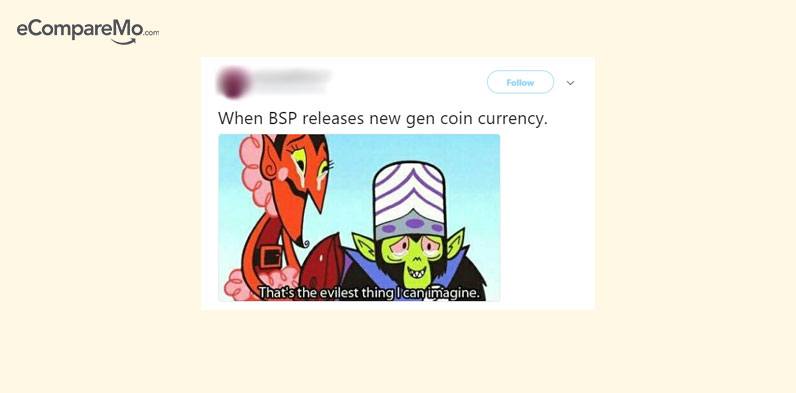BSP Reveals New Generation Philippine Coins—And Netizens Aren’t Buying It
4 min readJust recently, the Bangko Sentral ng Pilipinas (BSP) revealed the New Generation Currency (NGC) series of coins, set to go into circulation within the next few months.
The first of these to be revealed to the public was the P5 coin, which became available last December. Although the shiny coins are a welcome replacement for the BSP Coin Series that’s already been used for 22 years already, the new P5 coin was met with outrage.

Furious netizens ranted about the change in color and size of the coin, saying that it’s too close to the 22-year old P1 coin. Some Facebook posts even related how the posters interchanged the two coins because of their striking similarities in appearance. There even was an online petition to halt the circulation of the new coins.
Despite the outrage, there’s more to the new coins than meets the eye. So what’s the real deal with the NGC Coin Series?
Change is coming
In 2010, the BSP released a new series of bills that eventually replaced the former New Design Series banknotes in favor of better security and aesthetics. The designs highlighted the country’s best such as endemic flora and fauna, treasured natural wonders, key events in the Philippine history, and also featured the new BSP logo.
In addition, the new set of bills were harder to counterfeit, due to their use of iridescent bands and windowed security threads as well as the addition of abaca fibers.
(Read: New Generation Philippine Banknotes Rolled Out By The BSP—Spot the Differences)
For the NGC Coin Series, which will be placed in circulation this year, the coins will also get an upgrade in aesthetics and security. The back of the coins will again feature flora and fauna, along with the new BSP logo. Heroes will still be the face of the coins as the P1, P5, and P10 coins will bear the faces of Jose Rizal, Andres Bonifacio, and Apolinario Mabini, respectively. The profile of the heroes will share the obverse side with the denomination.
How do the new coins fare in terms of security? The NGC Coin Series put a lot of thought into anti-counterfeit features. Each coin will feature a different edge to give them a tactile difference. All coins will take advantage of microprinting technology to create finer prints such as the mint mark in babaylan. For the P5 and P10 coins, the obverse side will feature a microprint of “Republika ng Pilipinas†and “Bangko Sentral ng Pilipinas†on the reverse.
Confused? We prepared a handy table for you:
| Value | Diameter | Edge | Obverse |
Reverse |
|
10 peso |
27 mm | Milled with edge lettering “Bangko Sentral ng Pilipinas” | Apolinario Mabini, Republika ng Pilipinas, year mark, mint mark, “Republika ng Pilipinas” microprint |
Kapa-kapa (Medinilla magnifica), BSP logo, “Bangko Sentral ng Pilipinas” microprint, microdots |
|
5 peso |
25 mm | Plain |
Andres Bonifacio, Republika ng Pilipinas, year mark, mint mark, “Republika ng Pilipinas” microprint |
Tayabak (Strongylodon macrobotrys), BSP logo, “Banko Sentral ng Pilipinas” microprint |
|
1 peso |
23 mm |
Intermittent reeds |
Jose Rizal, Republika ng Pilipinas, year mark, mint mark |
Waling-waling (Vanda sanderiana), BSP logo |
|
 25 sentimo |
20 mm | Plain | Sun and three stars (stylized Philippine flag), Republika ng Pilipinas, year mark, mint mark |
Katmon (Dillenia philippinensis), BSP logo |
|
5 sentimo |
16 mm | Reeded | Sun and three stars (stylized Philippine flag), Republika ng Pilipinas, year mark, mint mark |
Kapal-kapal baging (Calotropis gigantea), BSP logo |
|
1 sentimo |
15 mm | Plain | Sun and three stars (stylized Philippine flag), Republika ng Pilipinas, year mark, mint mark |
Mangkono (Xanthostemon verdugonianu), BSP logo |
Material durability was also considered in creating the new coins, as their metallic silver finish is due to the nickel-plated steel used in minting them. This is a step up from the copper-based metals used in the previous coins that makes them more durable and more resistant to corrosion.
Why did the BSP change the material, anyway? Apart from anti-counterfeit reasons, the BSP also had to make sure that the production value of each coin is higher than the face value. Also known as seigniorage, this ensures the government makes a profit whenever they issue a currency.
Case in point: the pre-2004 P1 coin was 75 percent copper, and it would take more than twice of its amount to produce a single unit. After 2004, the metallic components of the P1 coin were changed to nickel-plated steel.
According to data scientist TJ Palanca, there are two big consequences if the BSP does not keep up with the seigniorage:
Coin smuggling
Coin hoarding for the purposes of smuggling is illegal in the Philippines. However, criminal enterprises can take advantage of the higher metal value of the coin by melting them and selling the raw metals. In the end, it’s the people who will be paying with those losses with their taxes.
Negative seigniorage
Negative seigniorage happens if the production value is higher than the coin’s face value. Aside from the risk of a coin’s demonetization, it can also hurt the economy as the BSP will be operating at a loss—and the public will pay for it.
Barya-ble response
When the P5 coin came out, the public was quick to condemn the change, saying that the color and diameter of the coin is too close to the BSP Current Series P1 coin. With only a millimeter of difference, one may not notice the difference in weight and feel of the coin when in a hurry.
(Read: 8 Things You Probably Didn’t Know About The Philippine Currency)
However, the initial reaction to the P5 coin was nothing compared to the reacion when the rest of the items in the series finally came out. From angry and colorful rants to witty takes, netizens love poking fun at the new coins. So, we went to Twitter—the “most credible†resource for netizen outrage—and collected some of their reactions regarding the new coins:












Sources: Philippine Information Agency, Asian Money Guide, Spot.ph
